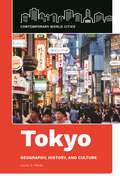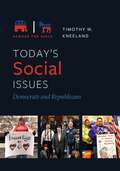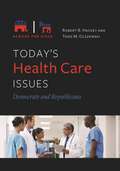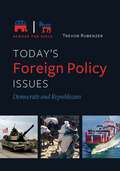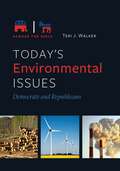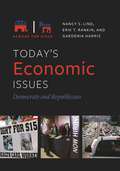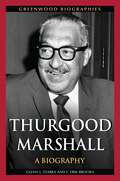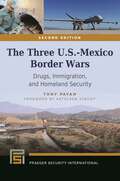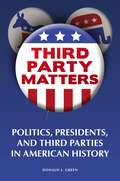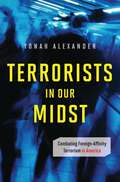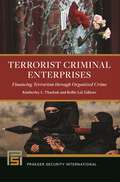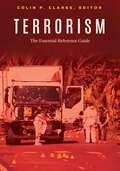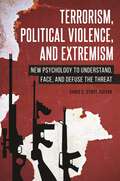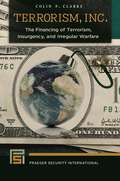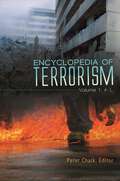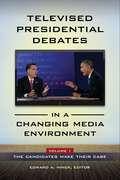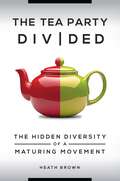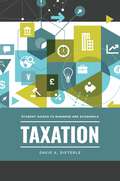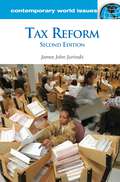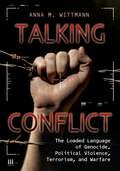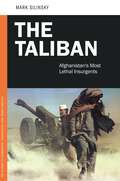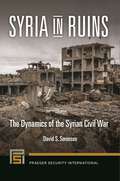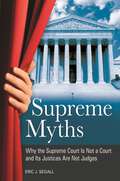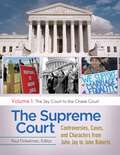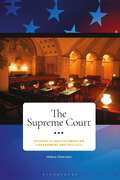- Table View
- List View
Tokyo: Geography, History, and Culture (Contemporary World Cities)
by Louis G. PerezThis indispensable one-volume narrative examines the history, culture, environment, economy, politics, future, and more of the city of Tokyo, Japan's political and cultural capital.Tokyo has endured and moved beyond horrible disasters in the 20th century, first an earthquake in 1923 and later the events that unfolded during World War II, to grow into one of the most populated cities in the world. This volume examines Tokyo's history, politics, culture, and more.Narrative chapters cover a wide breadth of topics, including Tokyo's location and geography, peoples, history, politics, economy, environmental issues and sustainability initiatives, local crime and violence, security issues, natural hazards and emergency management, culture and lifestyle, pop culture, and the future. Inset boxes entitled "Life in the City" include interviews with those who have lived in Tokyo as well as those who have traveled to the city, allowing readers to get a better idea of what daily life is like in this global megacity. A chronology, sidebars, and bibliography complete the text. The perfect one-stop resource for high school and undergraduate students, this volume is also suited to general readers interested in learning more about Tokyo and its role as a global city.
Today's Social Issues: Democrats and Republicans (Across the Aisle)
by Timothy W. KneelandCovering everything from abortion to gun control to immigration, this book explains policies and positions of today's Democratic and Republican parties, giving readers a complete understanding of modern-day American politics and the 2016 presidential race.This book cuts through rhetorical platitudes and partisan distortions to provide a balanced and up-to-date resource for understanding policy debates on social issues in statehouses around the country as well as in Washington, DC. It provides broad coverage of the parties and the forces that affect each party's positions, examining every major social policy and taking into account historical differences between Democrats and Republicans in an evenhanded manner, with emphasis on the key ideologies that set the two parties apart during the 2008–2014 midterms. Author Timothy Kneeland presents an in-depth study of the diversity of political opinion on today's most pressing social issues, digging deeper than the typical black-or-white presentation of these debates in the media. Readers will gain a detailed understanding of how the parties agree, disagree, and find compromise on the broad range of problems and issues facing American society in the 21st century.
Today's Health Care Issues: Democrats and Republicans (Across the Aisle)
by Robert B. Hackey Todd M. OlszewskiThis book provides a comprehensive introduction to significant U.S. health policy controversies, including Democratic and Republican responses to the coronavirus pandemic. It explores partisan divisions, major challenges, and policy preferences of key Democratic and Republican stakeholders.This volume provides readers with a broad overview of a variety of issues in contemporary health policy that span health care reform, health insurance, pharmaceuticals, public health, health care for underserved populations, and responses to the COVID-19 pandemic. The book explores the politics of each issue, drawing upon historical evidence, legislative research, public opinion polls, and the views of key decision makers from both Democratic and Republican perspectives. This coverage provides readers with a clear sense of how policymakers from each party think about the issues involved.This resource devotes special attention to the COVID-19 public health crisis, providing authoritative coverage of the actions, rhetoric, and policy choices of President Trump and his administration, governors across the nation, and leaders of Congress from both parties. This chapter, like all others in the book, is written so that it is accessible to readers from a variety of audience levels, including students and general readers.
Today's Foreign Policy Issues: Democrats and Republicans (Across the Aisle)
by Trevor RubenzerExamines the perspectives of Democrats and Republicans on dozens of major foreign policy issues of the 21st century, illuminating both areas of consensus and issues where partisan divisions are wide.From the earliest days of the republic through the Cold War and to the present day, American foreign policy has been colored by the beliefs and values of America's major political parties. Surveying the breadth and depth of partisan divisions on a variety of key foreign policy issues yields a better understanding of how partisanship has helped define U.S. leadership in the modern era.This book treats 38 individual foreign policy issues, each chosen for its timeliness and importance to American interests in the 21st century. For example, readers will learn about the partisan feelings regarding U.S. foreign policy toward Cuba that surfaced in the wake of President Obama's visit to Cuba in 2016 and his decision to resume diplomatic relations. These feelings serve as an excellent example of both partisan and intergovernmental divisions on a key U.S. foreign policy issue. Each entry contains an historical overview that will quickly bring readers "up to speed" on the issue, followed by an authoritative survey of positions and statements held by presidents, key leaders of Congress, and other important voices in both the Republican and Democratic parties. The book will serve as a vital and highly accessible reference for anyone—undergraduate university students, advanced high school students, and general readers—who needs a one-stop source for information about partisanship and U.S. foreign policy.
Today's Environmental Issues: Democrats and Republicans (Across the Aisle)
by Teri J. WalkerAn accessible and impartial survey of the positions of the Republican and Democratic parties on the most pressing environmental issues of our time, from climate change and wilderness preservation to air and water pollution.Today's Environmental Issues: Democrats and Republicans presents a unique perspective on party politics—one that impartially identifies similarities and differences regarding an array of topics ranging from fracking, sustainability, and pesticides to logging and noise pollution. Essays provide both historical information and up-to-date coverage of partisan opinions on today's environmental concerns. Written for upper level high school students, undergraduates, and general audiences interested in environmental issues and partisan viewpoints, this book enables readers to better understand the origins, details, differences, and commonalities of partisan opinions surrounding today's environmental concerns.Each environmental issue is unique with its own set of concerns and impacts, particularly when viewed from a party perspective. By examining a breadth of issues from the party viewpoint, readers can understand how the parties could work together or in opposition, depending on the environmental issue—and that the parties may not always be polar opposites on every issue, a characterization that is often portrayed in the media. Each essay includes a sidebar that presents a quick look at the party line, individuals who have shaped opinion or policy, or key court decisions.
Today's Economic Issues: Democrats and Republicans (Across the Aisle)
by Nancy S. Lind Erik T. Rankin Gardenia HarrisWhat are the real differences between the Democrats and the Republicans on major economic issues that influence the character and vitality of the American economy? This volume answers this question in a thorough, nonpartisan, and evenhanded fashion.Both the Democratic and Republican parties proclaim that they have the best interests of the nation and its people at heart. Both are also adamant that they have the best proposals and positions on economic policies, including taxation, spending priorities, wages, business regulation, and other influences on economic growth and household finances. This volume carefully examines the two parties' respective policies, providing a detailed yet readable and understandable look at how the parties agree, disagree, and find compromise on the broad range of problems and issues facing American society in the 21st century.Each entry includes an infographic that offers bulleted "at-a-glance" summaries of the two parties' positions on each issue today, an "Issue Overview" providing basic definitions and background for understanding the debate on each issue, and a main entry that explains prevailing party sentiments, the diversity of opinion within each party, and the shifts in party position on that issue over time. Selected entries also feature informative sidebars that supply additional content, such as primary documents that showcase the viewpoints of key political figures and institutions or biographical profiles of individuals who have helped shape their party's policies on the issue in question.
Thurgood Marshall: A Biography (Greenwood Biographies)
by Glenn L. Starks F. Erik BrooksThis book provides a detailed examination of the life and legal legacy of Supreme Court Justice Thurgood Marshall, including a discussion of the many legal cases in which he was involved.Thurgood Marshall was the first African American Supreme Court Justice. As a lawyer, he won the Supreme Court Case Brown v. Board of Education of Topeka that integrated all public schools in the United States. But Marshall's contributions extend far beyond significantly advancing the civil rights movement in this nation.Thurgood Marshall: A Biography discusses the life of Supreme Court Justice Thurgood Marshall in a chronological fashion, and then discusses his legacy after death. Students at all grade levels—including undergraduate and graduate college students—as well as historians and general readers interested in African American history , civil rights, or the U.S. legal system will find this book insightful and useful.
The Three U.S.-Mexico Border Wars: Drugs, Immigration, and Homeland Security (Praeger Security International)
by Tony PayanThis book addresses the three central issues that continue to dominate the U.S.-Mexico relationship today: drugs, immigration, and security. Nowhere is this more palpable than at the 2,000-mile border shared by the two countries.The U.S.-Mexico border remains a hot topic in the news—and a contentious one. This second edition of a popular work brings readers up to date on what is really going on at the U.S.-Mexico border and why. The book offers a detailed, history-based examination of the evolution of current conditions on the border, arguing that they exist due to a steady growth in the security concerns of the United States over almost two centuries. The author shows how the border has gone through four historical stages that, ultimately, have crippled the region, sacrificing its ability to produce prosperity in exchange for greater security. Combining depth and breadth, the book covers the economic relationship between Mexico and the United States, the deployment of technology, the bureaucratic interests that control the border landscape, the democratic deficit, and a detrimental lack of policy coordination. Issues such as drug trafficking and homeland security are considered as well. Demonstrating the internal and contradictory logic of American policy toward the border, the author argues that current conditions could lead to a return of authoritarianism in Mexico and a concurrent rise in anti-American sentiment.
Third-Party Matters: Politics, Presidents, and Third Parties in American History
by Donald J. GreenThis fascinating book looks at the select group of third parties that have made a real difference in U.S. politics and governance.Third parties have been a fixture in the American political landscape since the beginning of the two-party system. More than 300 of these groups have surfaced, but only a handful have made a real difference. Third-Party Matters: Politics, Presidents, and Third Parties in American History tells the intriguing stories of those 11 parties, starting with the antislavery Liberty Party of 1840.The parties deemed worthy of inclusion were selected because they met at least one of three criteria. They were spoilers who changed the outcome of an election, they had an important influence on government policy or the future of politics, and/or they had popular appeal, attracting at least ten percent of the vote. This investigation reveals the background behind each party's rise, what it stood for, who its leaders were—including larger-than-life personalities like Teddy Roosevelt, George Wallace, and Ross Perot—and the ultimate outcome of the election(s) in which the party participated.
Terrorists in Our Midst: Combating Foreign-Affinity Terrorism in America (Praeger Security International)
by Yonah AlexanderThis unique work analyzes for the first time how foreign-affinity terrorism works in a major democratic nation like the United States, and what this country must do to survive the terror challenge, on both conventional and unconventional levels.To date, no definitive study has dealt specifically with the role of American citizens in supporting a foreign political, ideological, and religious illegal agenda. Terrorists in Our Midst: Combating Foreign-Affinity Terrorism in America remedies that as six expert authors discuss the threats of Americans to security interests in the United States and elsewhere, exploring what can and should be done to reduce a risk that may threaten the very survival of the free world.Terrorists in Our Midst focuses not only on foreign nationals operating in the United States, but also on American citizens participating in terror networks at home and abroad. The book presents an overview of both conventional and unconventional terrorism, surveys the terrorist threat in the United States by state and nonstate actors, and analyzes the foreign-affinity links of American operatives in this country and abroad. Most important for the safety and security of the United States, it offers an assessment of what policies worked and what did not work, specifying a "best practices" agenda of recommendations that should be adopted by the United States and the international community.
Terrorist Criminal Enterprises: Financing Terrorism through Organized Crime (Praeger Security International)
by Christopher A. Kojm Kimberley L. Thachuk Rollie LalThis cohesive set of case studies collects scholarly research, policy evaluation, and field experience to explain how terrorist groups have developed into criminal enterprises.Terrorist groups have evolved from orthodox global insurgents funded by rogue sponsors into nimble and profitable transnational criminal enterprises whose motivations are not always evident. This volume seeks to explain how and why terrorist groups are often now criminal enterprises through 12 case studies of terrorist criminal enterprises written by authors who have derived their expertise on terrorism and/or organized crime from diverse sources. Terrorist groups have been chosen from different regions to provide the global coverage.Chapters describe and analyze the actors, actions, problems, and collaborations of specific terrorist criminal enterprises. Other elements discussed include links to such facilitating conditions as political culture, corruption, history, economy, and issues of governance. This work advances scholarship in the field of counterterrorism by expanding the understanding of these terrorist groups as entities not driven purely by ideology but rather by the criminal enterprises with which they often coincide.
Terrorism: The Essential Reference Guide
by Colin P. Clarke, EditorThis reference is essential reading for anyone attempting to understand modern terrorism by studying the arc of terrorism throughout history, from anarchists to Al Qaeda, ISIS, and beyond.As the rise of ISIS demonstrates, terrorist groups continue to destabilize vital regions around the world. This book features a series of introductory essays addressing how terrorism has evolved, spanning centuries to focus ultimately on the advent of modern terrorism, which has taken place from 1968 to the present. It discusses the emerging challenges presented by the proliferation of violent non-state actors, including Al Qaeda and ISIS. In addition, it explores exactly what has motivated terrorists and speculates as to how terrorism may continue to evolve.The core of Terrorism: The Essential Reference Guide comprises A–Z entries on terrorist organizations, major terrorist attacks, and prominent terrorist leaders. The work concludes with a carefully selected group of primary source documents essential to understanding the contemporary terrorist landscape and a detailed timeline that will help readers to place significant terrorism-related events in their proper context.
Terrorism, Political Violence, and Extremism: New Psychology to Understand, Face, and Defuse the Threat (Contemporary Psychology)
by Chris E. Stout, EditorA must-read for psychologists—clinical and academic alike—as well as for political scientists, policy analysts, and others working in the realm of terrorism, political violence, and extremism, this book carefully explores the theories, observations, and approaches of authorities in the field and addresses how and why terrorism has perpetuated for so long.Terrorism is now a regular topic in the news rather than a rare or an unusual occurrence. The possibility of violent terrorist acts constitutes a legitimate safety concern, regardless of one's country of residence: no longer can anyone assume that their location is beyond the reach or outside the targeted areas of any number of terrorist groups. Terrorism, Political Violence, and Extremism: New Psychology to Understand, Face, and Defuse the Threat examines why the number of terrorist attacks has greatly increased since the attacks on September 11, 2001 occurred, including well-known events such as the Madrid train bombings (2004), the London Underground bombings of 2005, the San Bernardino and Paris attacks (2015), and countless others, particularly in the Middle East and Africa. Beyond providing a careful and up-to-date assessment of the state of terrorism worldwide, which includes coverage of the religious and political origins of terrorist activities, the book pinpoints less-recognized and rarely studied aspects of terrorism, such as terrorism hysteria, sexuality, shame, and rape. The diverse perspectives within this unified volume are relevant to a breadth of subject areas, such as international psychology, military psychology, political science, political theory, religious studies, military theory, peace studies, military sciences, law enforcement, public health, sociology, anthropology, social work, law, and feminist theory.
Terrorism, Inc.: The Financing of Terrorism, Insurgency, and Irregular Warfare (Praeger Security International)
by Colin P. ClarkeThis in-depth, historical analysis of terrorism investigates the major funding streams of terrorists, insurgents, guerrillas, warlords, militias, and criminal organizations throughout the world as well as the efforts of the international community to thwart their efforts.Terrorist financing is an ongoing game of creating, concealing, and surreptitiously utilizing funds. This intriguing book considers every facet of guerrilla funding—from how activities are financed, to what insurgents do with the revenue they generate, to the range of countermeasures in place for deterring their moneymaking activities. Case studies prompt an analysis of past government responses and inform recommendations for countering irregular warfare worldwide.Author Colin P. Clarke presents the business side of terrorism, taking a look at the cash-producing ventures he labels "gray activities" such as diaspora support, charities, fraudulent businesses, front companies, and money laundering as well as "dark activities" including kidnapping for ransom, robbery, smuggling, trafficking, and extortion. He considers the transnational efforts to stop terrorist activities—from wiretaps and electronic surveillance to financial sanctions and the freezing of funds and accounts—and points to the emergence of interagency task forces for detaining and destroying the operations of major criminal organizations across the globe.
Encyclopedia of Terrorism [2 volumes]: [2 volumes]
by Peter ChalkA valuable, up-to-date reference tool for understanding the latest developments in national and international terrorism—one of the most pressing security challenges facing the world today.Terrorism has emerged as one of the main foreign and national policy challenges of the 21st century. Encyclopedia of Terrorism provides comprehensive coverage of the events, individuals, groups, incidents, and trends in terrorism in the modern era. This essential work presents accurate, concise, and crucial information on developments since the watershed events of September 11, 2001, providing readers with an invaluable reference tool for understanding major developments that have occurred in domestic and international terrorism. The work is fully cross-referenced to provide a comprehensive research tool for high school students, academics, security analysts, and other readers interested in the study of terrorism.
Televised Presidential Debates in a Changing Media Environment [2 volumes]: [2 volumes]
by Edward A. HinckThis two-volume set examines recent presidential and vice presidential debates, addresses how citizens make sense of these events in new media, and considers whether the evolution of these forms of consumption is healthy for future presidential campaigns—and for democracy.The presidential debates of 2016 underscored how television highlights candidates' and campaigns' messages, which provide fodder for citizens' widespread use of new media to "talk back" to campaigns and other citizens. Social media will continue to affect the way that campaign events like presidential debates are consumed by audiences and how they shape campaign outcomes. This two-volume study is one of the first to examine the relationship between debates as televised events and events consumed by citizens through social media. It also assesses the town hall debate format from 1992 to 2016, uses the lens of civil dialogue to consider how citizens watch the debates, and considers the growing impact of new media commentary on candidate images that emerge in presidential and vice presidential debates.Televised Presidential Debates in a Changing Media Environment features contributions from leading political communication scholars that illuminate how presidential debates are transforming from events that are privately contemplated by citizens, to events that are increasingly viewed and discussed by citizens through social media. The first volume focuses on traditional studies of debates as televised campaign events, and the second volume examines the changing audiences for debates as they become consumed and discussed by viewers outside the traditional channels of newspapers, cable news channels, and campaign messaging. Readers will contemplate questions of new forms, problems, and possibilities of political engagement that are resulting from citizens producing and consuming political messages in new media.
The Tea Party Divided: The Hidden Diversity of a Maturing Movement
by Heath BrownUnlike previous books on the Tea Party, this work looks at the second phase of party growth to show that what was once considered a monolithic movement is truly a collection of different opinions.Since the Tea Party exploded onto the American political scene, it has matured and changed, but the differences that now exist within the movement are largely unacknowledged. A more nuanced understanding is called for. Previous treatises have sought explanations for the rise of the movement and focused primarily on its early days. This book, in contrast, focuses on understanding the diversity within the party, challenging the notion that the Tea Party is a homogeneous political movement defined mainly by its ultra-conservatism, regionalism, and rigid political orthodoxy.To accurately depict the Tea Party as it exists today, the book explores how the party evolved from its first phase to its second, examining important distinctions in terms of who has joined and who has served in Congress and other offices. Differences in Tea Party organizations around the country are examined and their funding sources considered. The book also explores the political positions taken by Tea Party members, looking at the voting records of party legislators to see if they've adhered to stated movement objectives. Finally, and perhaps most intriguingly, the author speculates on what this all means and suggests possible futures for the diverse Tea Party strands.
Taxation (Student Guides to Business and Economics)
by David A. DieterleThis engaging and accessible book is a must-read for every taxpayer, young and old. It explores the many forms of taxation; how taxes are created, collected, and spent; and why certain aspects of taxation are so controversial."In this world, nothing can be said to be certain, except death and taxes." Benjamin Franklin wrote this now-famous quote more than 200 years ago, and taxation remains just as important (and inevitable) today as then. Taxes are a fact of life for almost everyone, and the public goods and services they pay for are enjoyed by all citizens. While taxes are undeniably necessary, the specifics of what should be taxed, who should pay taxes, and at what rate remain hotly debated by economists, government officials, and regular citizens. The first in Greenwood's new Student Guides to Business and Economics series, Taxation gives readers an in-depth yet reader-friendly look at one of economics' foundational concepts. Using simple language and relevant real-world examples, the book explores the different forms of taxation, the necessary components of any tax, how taxes are created and collected, and much more. It also highlights contemporary controversies related to taxation, including whether or not "sin taxes" actually discourage unwanted behaviors like smoking and how best to simplify the tax filing process.
Tax Reform: A Reference Handbook (Contemporary World Issues)
by James John JurinskiAn authoritative but accessible reference, this book enables anyone to truly understand both the background and operation of the U.S. tax system and current tax reform proposals.Dissatisfaction with high taxes is literally an American tradition; indeed, the American Revolution that led to the founding of the United States started as a tax revolt. Today, widespread displeasure with our tax system continues, as demonstrated by the strong anti-tax position of the recent Tea Party movement.Tax Reform: A Reference Handbook, Second Edition introduces lay readers to taxes in general, the U.S. tax system in particular, and the issues involved in reforming the system. Details regarding past tax reform measures are provided to lend relevance and perspective to recent tax reform proposals, such as replacing the income tax (and the IRS) with a federal sales tax. The author stresses political rather than technical issues, and presents all viewpoints on this hotly debated topic fairly.
Talking Conflict: The Loaded Language of Genocide, Political Violence, Terrorism, and Warfare
by Anna M. WittmannIn today's information era, the use of specific words and language can serve as powerful tools that incite violence—or sanitize and conceal the ugliness of war. This book examines the complex, "twisted" language of conflict.Why is the term "collateral damage" used when military strikes kill civilians? What is a "catastrophic success"? What is the difference between a privileged and unprivileged enemy belligerent? How does deterrence differ from detente? What does "hybrid warfare" mean, and how is it different from "asymmetric warfare"? How is shell shock different from battle fatigue and PTSD? These are only a few of the questions that Talking Conflict: The Loaded Language of Genocide, Political Violence, Terrorism, and Warfare answers in its exploration of euphemisms, "warspeak," "doublespeak," and propagandistic terms.This handbook of alphabetically listed entries is prefaced by an introductory overview that provides background information about how language is used to obfuscate or minimize descriptions of armed conflict or genocide and presents examples of the major rhetorical devices used in this subject matter. The book focuses on the "loaded" language of conflict, with many of the entries demonstrating the function of given terms as euphemisms, propaganda, or circumlocutions. Each entry is accompanied by a list of cross references and "Further Reading" suggestions that point readers to pertinent sources for further research. This book is ideal for students—especially those studying political science, international relations, and genocide—as well as general readers.
The Taliban: Afghanistan's Most Lethal Insurgents (PSI Guides to Terrorists, Insurgents, and Armed Groups)
by Mark SilinskyUnderstand the complexities of the most lethal insurgent group of America's longest war—the Taliban.Battle hardened, tribally oriented, and deeply committed to its cause, the Taliban has proven itself resourceful, adaptable, and often successful. As such, the Taliban presents a counterinsurgency puzzle for which the United States has yet to identify effective military tactics, information operations, and Coalition developmental policies. Written by one of the Department of the Army's leading intelligence and military analysts on the Taliban, this book covers the group's complete history, including its formation, ideology, and political power, as well as the origins of its current conflict with the United States. The work carefully analyzes the agenda, capabilities, and support base of the Taliban; forecasts the group's likely course of action to retake Afghanistan; and details the Coalition forces' probable counterinsurgency responses. Author Mark Silinsky also reviews the successes and failures of the latest U.S. counterinsurgency doctrine to extrapolate the best strategies for future counterinsurgency campaigns.
Syria in Ruins: The Dynamics of the Syrian Civil War (Praeger Security International)
by David S. SorensonSyria is home to one of the most brutal and protracted civil wars in history, posing a threat to global stability and enabling the expansion of the Islamic State (sometimes called "ISIS"). This in-depth analysis reveals the beginning, present state, and future of this conflict.The current crises involving ISIS have attracted worldwide attention to the complex politics and cultural panorama of the Middle East, including Syria. Political analyst and author David S. Sorenson discusses the ongoing civil war in Syria from its origins, to its key players, and to its propagation into neighboring countries. In the process, the work delves into Syria's demographics, history, economy, and security to illustrate the civil war's impact on the Middle East and the world. This in-depth analysis covers the Assad regime, ISIS's role in the region, possible outcomes of the conflict, and security implications for the country.Starting with a history of Syria, the work identifies the factors that have contributed to the onset and continuation of the civil war, moves on to an analysis of the outbreak and growth of the war, and points out key factors that fueled its intensity. A look at the Islamic State considers the internationalization of the Syrian civil war, explaining how the addition of many parties outside of Syria have made the war more violent and protracted. The book concludes by considering alternative endings for the conflict and addressing the role of world powers in the conflict and its outcome.
Supreme Myths: Why the Supreme Court Is Not a Court and Its Justices Are Not Judges
by Eric J. SegallThis book explores some of the most glaring misunderstandings about the U.S. Supreme Court—and makes a strong case for why our Supreme Court Justices should not be entrusted with decisions that affect every American citizen.Supreme Myths: Why the Supreme Court is Not a Court and its Justices are Not Judges presents a detailed discussion of the Court's most important and controversial constitutional cases that demonstrates why it doesn't justify being labeled "a court of law."Eric Segall, professor of law at Georgia State University College of Law for two decades, explains why this third branch of the national government is an institution that makes important judgments about fundamental questions based on the Justices' ideological preferences, not the law. A complete understanding of the true nature of the Court's decision-making process is necessary, he argues, before an intelligent debate over who should serve on the Court—and how they should resolve cases—can be held. Addressing front-page areas of constitutional law such as health care, abortion, affirmative action, gun control, and freedom of religion, this book offers a frank description of how the Supreme Court truly operates, a critique of life tenure of its Justices, and a set of proposals aimed at making the Court function more transparently to further the goals of our representative democracy.
The Supreme Court [4 volumes]: Controversies, Cases, and Characters from John Jay to John Roberts [4 volumes]
by Paul FinkelmanAn insightful, chronological—by chief justice—examination of the Supreme Court that enables students and readers to understand and appreciate the constitutional role the Court plays in American government and society.American citizens need to understand the importance of the Supreme Court in determining how our government and society operates, regardless of whether or not they agree with the Court's opinions. Unfortunately, the role and powers of the third branch of government are not well understood by the American public. After an introduction and overview to the history of the Supreme Court from 1789 to 2013, this book examines the Court's decisions chronologically by Chief Justice, allowing readers to grasp how the role and powers of the Court have developed and shifted over time. The chapters depict the Court as the essential agent of review and an integrated part of the government, regardless of the majority/minority balance on the Court, and of which political party is in the White House or controlling the House or Senate.
The Supreme Court (Student Guides to American Government and Politics)
by Helena SilversteinThis accessible guide to the U.S. Supreme Court explains the Court's history and authority, its structure and processes, its most important and enduring legal decisions, and its place in the U.S. political system.A 2018 Pew Research Center poll found that while 78 percent of Democrats and Democratic-leaning independents believed that the Supreme Court should base its decisions on the "modern" meaning of the Constitution, 67 percent of Republicans and Republican-leaning independents asserted that Justices should rely on the Constitution's "original meaning."The Court often is the final arbiter of polarizing battles that originate in other branches of government. At the same time, however, its structural insulation from Congress, the Presidency, and electoral politics make the Supreme Court—at least in theory—well positioned to rise above the rough-and-tumble of politics. This book examines the power of the Supreme Court in America's system of democratic governance in several ways. These include: reviewing debates over whether justices should interpret the Constitution in line with its "original meaning" or in accordance with present-day understandings; exploring the processes and factors that shape how cases are chosen and decided; considering contentious battles over the selection of justices; and examining the impact of the Court on American culture and society.
